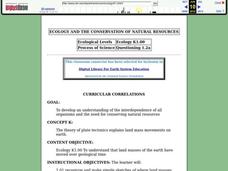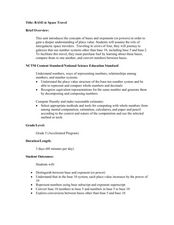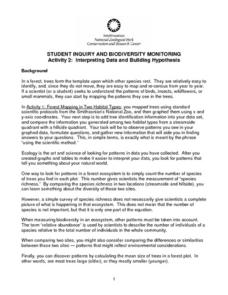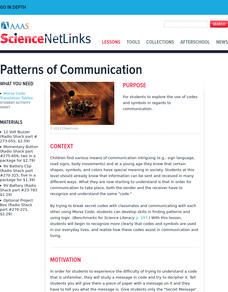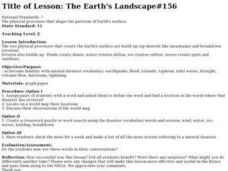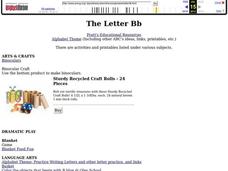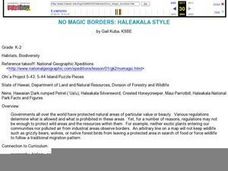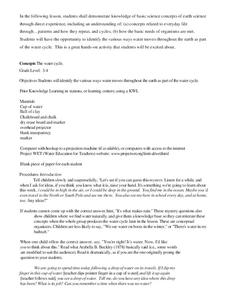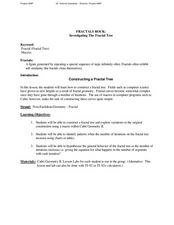Curated OER
Shapes and Patterns in Art and Oceans
First graders draw, cut out, and design their own fish shapes by cutting out shapes and putting them together. In this shapes and patterns worksheet, 1st graders also construct a stamp and print patterns with stamps to repeat a...
Curated OER
Pattern Detectives
Students discover patterns in language, math and science. They experience patterns by hearing stories, and becoming pattern detectives.
Science Matters
Ring of Fire
Over a period of 35 years, earthquakes and volcanoes combined only accounted for 1.5 percent of the deaths from natural disasters in the United States. The 15th lesson in a 20-part series connects the locations of earthquakes and...
Curated OER
Symmetry in Butterflies
Young scholars design butterflies. In this symmetry lesson, students examine butterfly pictures, discuss the symmetry of their wings, and create their own symmetry patterns.
Curated OER
Shape Hunt
Explore the world of shapes! After free tangram exploration and pair share time, learners describe various patterns and shapes in both the natural and designed world. They investigate the use of tangrams to create patterns and shapes.
Chicago Botanic Garden
Causes and Effects of Climate Change
Wrap-up a unit on global climate change with a lesson that examines the causes and effects of climate change. Learners fill out a chart that represents what they think causes climate change—natural and human-based—and what they think...
Chicago Botanic Garden
Recognizing Change (Observation vs. Inference)
What is the difference between making inferences and making observations? Young climatologists refer to a PowerPoint to make observations on each slide. They record their observations in a provided worksheet before drawing a...
Curated OER
Ecology And the Conservation of Natural Resources
Students study Alfred Wegener's theory of continental drift and how the continents were connected in one large land mass called Pangaea. They examine plate tectonics and the theory that the earth's surface is composed of large moving...
Curated OER
BASE-ic Space Travel
For this 3-day place-value lesson, upper-elementary kids investigate the base 5 and base 2 systems as an introduction to exponents and powers. They create a pocket chart to help ground their understanding of bases, exponents, and powers,...
Curated OER
Interpreting Data and Building Hypothesis
High schoolers define the term species, and graph species data together with previously collected data at the National Zoo. They interpret graphed data and recognize patterns in the streamside quadrant versus hillside quadrant. Students...
Curated OER
Sorting
Young scholars understand that sorting helps find things at a later date. In this sorting lesson, students use a website game and sort the common items. Young scholars sort folders and other classroom items. Students discuss how sorting...
Curated OER
The Mystery of the Missing Hummingbirds
Students record scientific observations in a science journal. In this season lesson, students make observations about each of the seasons and record in their journals. Students record organisms response to seasonal changes...
Curated OER
Science: The Water Cycle
Students examine the various stages of the water cycle. In groups, they complete a hands-on activity by creating model water cycle. Students design posters representing each of the seven stages of the water cycle.
Curated OER
The Sun Affects Earth
Third graders read, write, and listen to information about the sun and its effects on the Earth.as it relates to its axis, orbit, rotate, and revolution. In this solar system lesson, 3rd graders examine how the sun...
Curated OER
The Earth's Landscape#156
Students define a word from the natural disaster list, find a location in the world where this type of disaster has occurred and discuss what they have identified. They design a crossword puzzle of natural disaster words or check a...
Curated OER
Growth Stages 1: Infancy and Early Childhood
Students explore biology by completing a human growth worksheet. In this child development lesson, students read assigned text about the human birth process and the ideal growth patterns for a child. Students answer study questions about...
Curated OER
Our Zoo Friends
First graders plan and create a model zoo depicting the natural habitats of animals. Their models include animals and a display of written factual information about the animals. Students present their project by conductig a tour of...
Curated OER
The Letter Bb
Students participate in a variety of activities to practice words with the Bb sound. For this Bb sound lesson, students use craft rolls to create butterflies. Students create a letter book with B words
Curated OER
Rainfall Mapping
Students explore rainfall and habitats. In this rainfall lesson, students explore the relationships among rainfall, vegetation, and animal habitats. Resources are provided.
Curated OER
No Magic Borders: Haleakala Style
Students discuss borders and boundaries. They discuss pollution and the fact that boundaries cannot stop pollution and that pollution affects even protected wildlife and plants. They participate in an activity in which they must place...
Curated OER
The Water Cycle
Students access prior knowledge of the water cycle by completing a KWL. For this water cycle lesson, students follow the movement of water through the water cycle.
Curated OER
Comparing and Contrasting
Young scholars practice compare and contrast skills. In this science and language development lesson, students complete a T chart generating traits of a snail and a clam. Young scholars complete a related worksheet.
Curated OER
Fractals Rock
Students identify the repeated sequences of a pattern. In this geometry lesson plan, students identify fractals in patterns and nature. They construct a fractal tree and make conjectures.
PHET
CME Plotting
Young scientists build on their previous knowledge and apply it to coronal mass ejections. By plotting the path of two different coronal mass ejections, they develop an understanding of why most don't collide with Earth.







